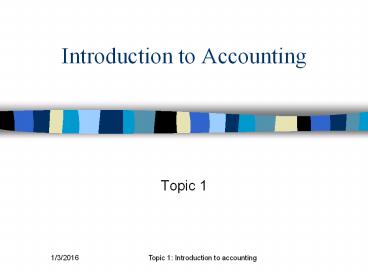Introduction to Accounting - PowerPoint PPT Presentation
1 / 25
Title: Introduction to Accounting
1
Introduction to Accounting
- Topic 1
2
Learning outcomes
- By the end of this topic you should be able to.
- 1.Explain the purpose of accounting
- 2. Identify users of accounting information
- 3. Describe the importance of accounting
information to various users - 4. Identify the various accounting measurement
basis. - 5. Explain the importance of professional ethics
in accounting - 6. Describe the accounting equation
- 7. Identify organisations that influence the
accounting profession - 8. Describe accounting concepts and conventions
3
Definition of accounting
- Recording of financial transactions for decision
making - Wood and Sangster (2005) defines accounting as a
systematic recording of transactions having an
impact in a business and availing the information
to decision makers on a timely basis. - Through out the course you will learn
- The basics in accounting
- Importance of accounting information, and
- How to prepare financial statements
- This is an introductory lesson
4
Purpose of accounting
- Provide information on financial position of an
enterprise - Information on performance over a period
- Balance sheet shows financial position
- Income statement, cash flow statement and
statement of changes in equity show financial
performance
5
Users of accounting information
- Stock holders
- Potential investors
- Management
- Employees
- Potential investors
- Employees
6
Stock holders
- Interested in knowing profitability of an
organisation - Use information to determine whether additional
capital should be done - Use information to evaluate how management is
carrying out their roles
7
Potential investors
- Are interested in investing in the organisation
- Use financial accounts to evaluate strength of an
organisation - Compute intrinsic value of shares using financial
accounts
8
Management
- Require timely accounting information for
decision making - Use financial information to make plans
- Use accounting data to perform performance
evaluation - In addition to financial accounts, they require
detailed management accounts
9
Employees
- Financial information provide an idea about their
job security - Employees unions use information to negotiate
better terms of service - Their performance evaluation is informed by
financial results
10
Others
- Students use the information for research and
training - Regulatory agencies use the data in assessing
financial health for a business such as capital
markets - Tax authorities use financial accounts to assess
tax liability
11
Accounting measurement
- Attaching monetary value to transactions
- Bases
- Transactional values relates to cost of
purchases as well as sales values - Fair value value of present value of future cash
flows - Fair value Market price less selling costs
12
Accounting measurement contd
- Historical costs purchase price. Mainly used in
accounting for non current assets - Replacement cost cost of acquiring a similar
asset with the same conditions - Net book value historical cost less depreciation
13
Ethical considerations
- Accounting information is of high value to
decision makers. - Need to provide credible information
- A number of corporate frauds have involved
accountants - Need for one to behave professionally and observe
code of conduct - One should be independent, objective, exercise
due care, professionalism and integrity
14
Accounting equation
- Assets Capital Liabilities
- Economic resources (Assets) are generated from
either owners capital and or debt financiers
(liabilities)
15
Organisations that influence accounting practice
- The profession is highly regulated
- Professional bodies such as MICPA develop code of
conduct - Accounting measurement guided by a reporting
frame work - International accounting standard setters such as
IASB guide accounting treatment
16
Accounting concepts and conventions
- Five main concepts and conventions
- Matching
- Monetary unit
- Going concern
- Time period
- Separate entity
17
Monetary unit
- Transactions can be converted into a unit of
measure based on the operating currency - Monetary value attached to non cash items
- Helps to determine value of an entity
18
Going concern
- A reporting entity to continue operating into the
future - No winding up of activities are foreseen
- Helps to value assets at their net book values
19
Time value
- The continuous life time of an entity can be
separated into distinct reporting periods - Useful in assessing performance of an
organisation over time - Position of an organisation can be determined at
a certain point in time
20
Separate entity
- The business is distinct from owners
- Owners transact with the business as third
parties - Helps to assess the value of an organisation
independent of owners - Economic value with owners are determined
- Contribution of the entity in enhancing owners
wealth is evaluated
21
Matching
- Resources generated are compared with those used
up in the process - Excess (profits) or short falls (loss) on net
realization used to assess performance - Organisations generating resources in excess of
consumption are good performers
22
Matching contd
- Resources used in generation of future profits
are capitalised - Expenses are charged on the time period for which
they were used to generate revenues - Revenues matched with expenses
23
Conclusion
- Accounting information is critical in decision
making for various users - Accountants should adhere to professional ethics
- Watchdog organisations enhance credibility of
financial information - Reporting framework developed to guide
accountants
24
Further reading
- Rice, A (2002). Accounts demystified How to
understand financial accounting. Prentice Hall - Wood, F, and Sangster, A. (2005) Business
Accounting 1 (10th ed.). Prentice Hall
25
Questions
- Quiz































